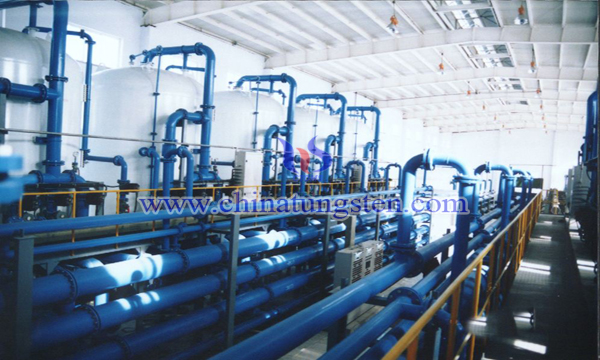Tungsten and Molybdenum Separation by Ion Exchange
- Details
- Category: Tungsten Information
- Published on Wednesday, 26 September 2018 22:14
Due to the similar properties of tungsten and molybdenum, separation of tungsten and molybdenum has always been a key and difficult problem in tungsten smelting industry. It is well known that the traditional ion exchange process is difficult to solve the problem of W-Mo separation at one time, resulting in a large number of supplementary materials, but also to bring a lot of environmental management difficulties to enterprises.

Among the prior art, the ion exchange process for highly efficient separation of tungsten and molybdenum has not yet formed a mainstream in the industry, and the following technical points have not been broken through: 1. The amount of molybdenum adsorbed by resin is not large; 2. It is difficult to elute molybdenum adsorbed by resin, so that the resin can be reused efficiently; 3. It is difficult to operate the whole process. In view of the above problems, some enterprises have improved the ion exchange method, so that it can be more efficient to deal with the separation of tungsten and molybdenum problems, the process includes the following steps:
Step 1 includes the following steps:
A, the tungsten ore containing molybdenum is made into tungsten peak solution: the tungsten ore containing molybdenum is milled and then added to NaOH alkali boiling, the product is filtered by pressure, the ingredients are mixed, and then the ion exchange is carried out; finally the product is leached with NH4Cl and NH3·H2O to get tungsten peak solution.
B, add (NH4) 2S to the tungsten containing peak solution to step A, and then cure it.
C, adding weak alkaline macroporous resin to the sulfurized solution of step B for ion exchange, the solution containing high tungsten and low molybdenum and the molybdenum resin supported on it were obtained.
D, CuSO4 was added to the high tungsten low molybdenum solution in step C.
E, the products obtained by step D were pressed to obtain molybdenum slag and tungsten containing solution.
F, crystallizing APT from the tungsten solution obtained in step E.
G, adding NaOH, oxidant and activator in sequence to the molybdenum resin containing loading in step C to regulate PH, and controlling the elution temperature to 50 ℃.
H, the products obtained from step G were washed by NH3·H2O.
I, crystallizes ammonium molybdate from the solution obtained in step H.
Compared with the existing technology, the improved ion exchange process has a higher efficiency, because the resin greatly removes the molybdenum from the sulfidation peak, so when the residual molybdenum is removed by selective precipitation method, a large amount of copper sulfate is saved, and the amount of ammonium sulfide and copper sulfate is reduced, more than 90% of molybdenum can be used for raw materials. The ammonium molybdate with high purity and added value is produced, and the problem of storing molybdenum slag in the warehouse is solved. The environmental pressure of the enterprise is reduced and the efficiency is improved.
- Tungsten Manufacturer & Supplier, Chinatungsten Online: www.chinatungsten.com
- Tungsten News & Prices of China Tungsten Industry Association: www.ctia.com.cn
- Molybdenum News & Price: news.molybdenum.com.cn
- Tel.: 86 592 5129696; Fax: 86 592 5129797; Email: sales@chinatungsten.com



 sales@chinatungsten.com
sales@chinatungsten.com